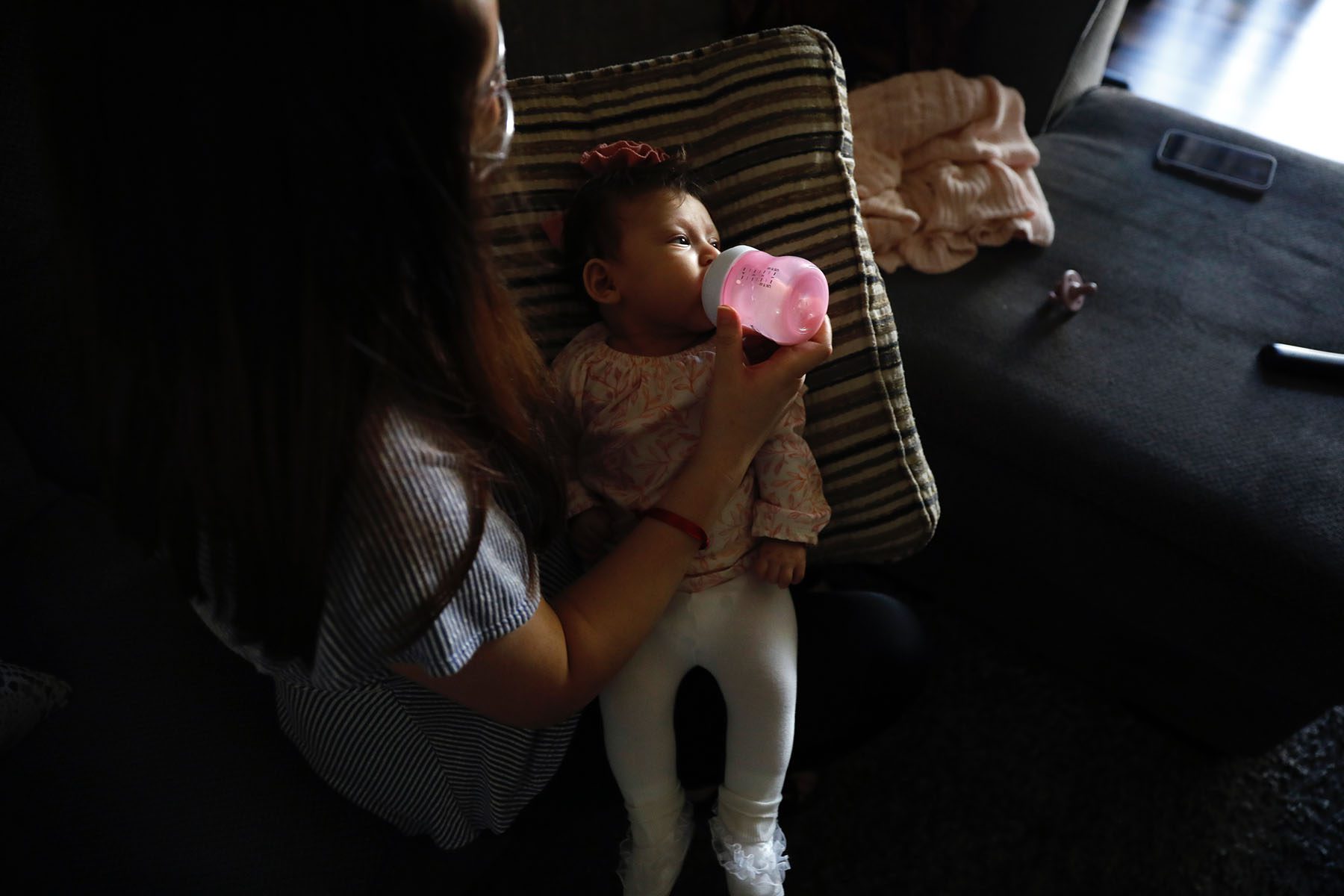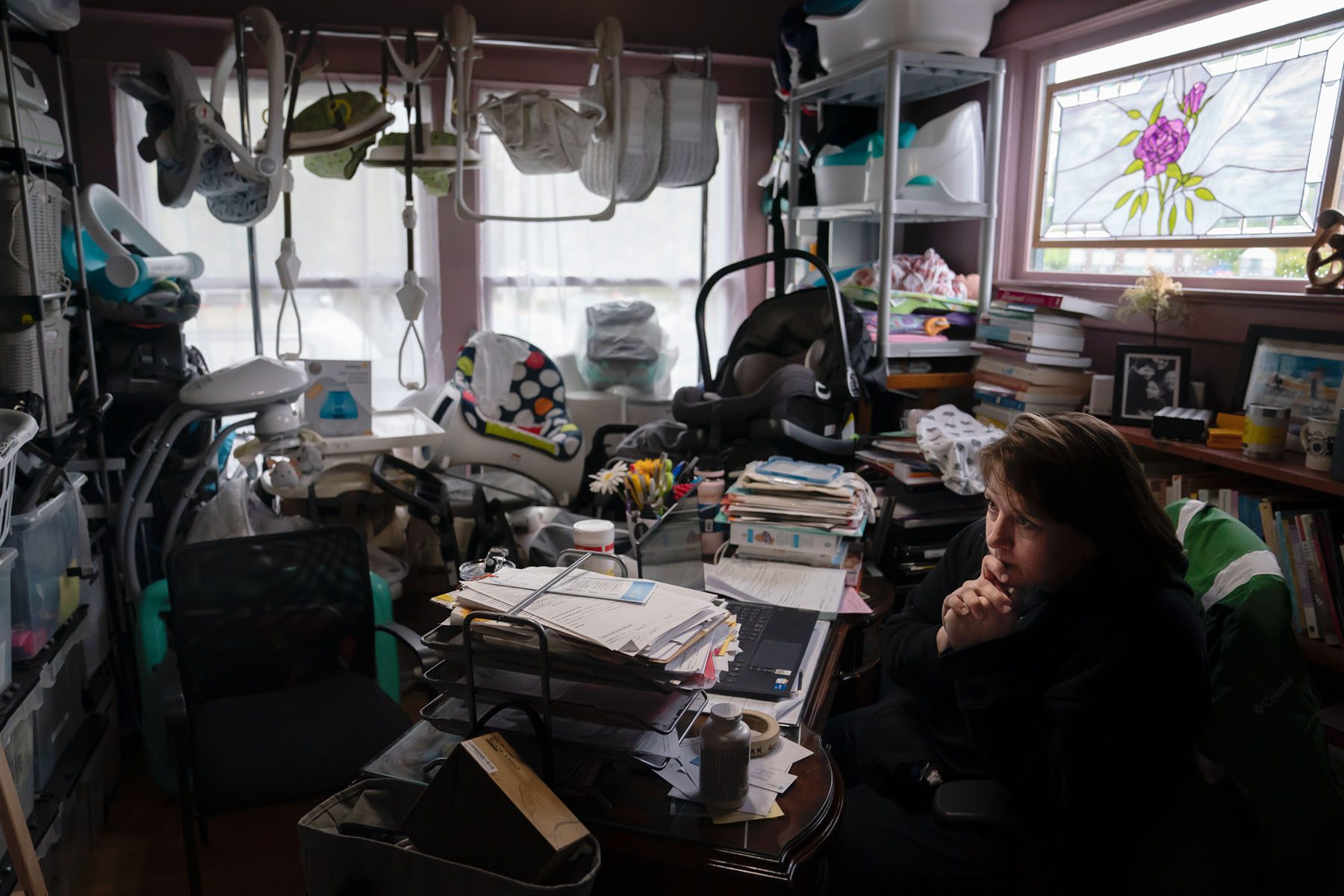Your trusted source for contextualizing the news. Sign up for our daily newsletter.
Last summer, when her daughter was still drinking formula, Brittani Roberts often drove from store to store trying to find enough to feed her.
When her daughter was teething last month, Roberts repeated the exercise — this time driving to five stores while her friend tried an additional four to find Tylenol or Motrin for children. Neither of them was successful.
“It’s so stressful, because your kid is miserable and sick with a cold and teething, and you want to get them relief, but you can’t find them any medication,” said Roberts, who lives in Salt Lake City. Her mother eventually found children’s Tylenol after trying different stores in town and mailed it to her.
The shortages, Roberts said, “really have affected us.”
It’s a familiar modern tableau: Parents standing in front of bare shelves where infant formula, children’s medications and tampons were once stocked.
Shortages like these can happen in any given year. But supply chain disruptions and pandemic shopping patterns have caused a confluence of shortages for parents and caregivers, after several difficult years that have unmoored people’s professional and personal lives.
The formula shortage has been ongoing since February 2022, when a Michigan factory closed down following a recall. In mid-2022, a tampon shortage wiped shelves due to supply chain issues. Supplies of children’s Tylenol and Motrin dropped in the fall, when cases of COVID-19, flu and the respiratory virus RSV shot up — that shortage lingers into this year. Adderall, the medication primarily used to treat attention deficit hyperactivity disorder (ADHD), which is usually first diagnosed in childhood, is still in shortage. So, too, is the antibiotic amoxicillin, according to the Food and Drug Administration.
For parents, the mental and emotional load of navigating all these shortages has only grown.
“It’s a combination of time-consuming and mentally draining that is putting an amazing burden on working parents,” said Audrey Goodson Kingo, the editor-in-chief of Mother Honestly, a platform for working moms. “It’s a question of, ‘Do you want to spend your time or do you want to spend your money?’ You’re going to spend something.”
Dr. Deborah Greenhouse, a pediatrician in Columbia, South Carolina, has been managing the compounding shortages for a year. It all started with formula, and then was followed by the shortage of amoxicillin. When it was clear the antibiotic was in short supply, she started prescribing other antibiotics.
“It becomes a cascade,” Greenhouse said. “The more you have to use something different, the more you fall into shortages of all of them until you get to a point where literally it is almost impossible to find children’s antibiotic suspensions, and that is still largely where we are now.”
Her practice has been working to identify pharmacies that are more likely to have children’s medications in stock and are sending paper prescriptions when they can to help parents have something on hand in case they do run across a pharmacy that has the medication their child needs, instead of waiting for their doctor to send it electronically.
But with Adderall, that’s not really an option. The challenge there is heightened because the drug is a controlled substance. During the pandemic, relaxed rules allowed doctors to prescribe controlled substances using telehealth, waiving an in-person requirement. That, combined with more attention on ADHD and its symptoms, particularly as parents and kids were at home, led to a rise in the number of prescriptions for Adderall. Higher demand with only limited supply is the perfect recipe for a shortage, and other factors may be at play too, including COVID-19 labor shortages. A shortage of Adderall hurts kids especially: About 10 percent of children ages 3 to 17 have been diagnosed with the disorder, according to the Centers for Disease Control and Prevention.
“You really do get into this awful situation where you send the prescription into the pharmacy, the pharmacy doesn’t have it. The parent has to call around, call around, call around and find the prescription and then call us back. We have to send it again. It is incredibly time-consuming,” Greenhouse said. “At the end of the day, the person who is getting the worst of it is the child … it may take days for the family to find it, and the child is struggling in the meantime.”

Greenhouse’s office fields calls from angry parents daily who can’t find what they need for their kids.
“If we spent the amount of time necessary to find all the prescription medications for our families right now, we would never see another patient — we would literally be sitting here all day on the phone talking to pharmacies,” she said.
Those struggles have also played out with over-the-counter medications over the past few months. Johnson & Johnson, the producer of the brand-name Tylenol and Motrin for children, told members of Congress last month that in response to “unprecedented demand,” it has increased production by 50 percent and its facilities have been running around the clock since April 2022. But the shortage, which peaked late last year, still lingers. Walgreens has removed the limit on how many over-the-counter pediatric medications customers can purchase, but at CVS, a two-product limit is still in place for children’s pain relief medication.
In a statement, Johnson & Johnson said it’s not experiencing widespread shortages, but products may be less readily available at some stores as it continues to “experience high consumer demand driven by an extremely challenging cold & flu season.”
“We recognize this may be challenging for parents and caregivers, and are doing everything we can to make sure people have access to the products they need,” Johnson & Johnson said.
In January, Christianne Mariano’s two sons were sick at home with a cold and strep throat. At her grocery store pharmacy, she grabbed the last children’s pain and fever reducer left on an otherwise empty shelf. Her sister-in-law, a nurse, couldn’t find any — Tylenol or any other brand — for her three sick daughters. A fellow nurse gave her some she had at home.
“Ever since the pandemic started, obviously we’re all kind of used to random things being out at the grocery store now, including in the medicine aisle, but this was mind-boggling,” said Mariano, who lives in New Jersey. “The emotional labor that has gone into it is definitely very high.”
Mariano considers herself lucky — she was able to find what she needed.
But there are families who have neither the means nor the time to drive around from store to store. Their job might not offer that kind of flexibility or they might not have the resources to spend on gas or purchasing alternates of certain medications. Low-income families are the majority of those who purchase formula, and they have continued to experience the shortage as other parts of the country have rebounded. In the coming months, eased regulations that were put in place to help those families access formula with government assistance will expire even as the shortage continues.
Greenhouse, the pediatrician, said half of her patient population is on Medicaid, and a portion don’t have insurance.
“The families with private insurance and with resources have the ability to get to a pharmacy that may be 15 or 20 minutes away. They have the ability to get that medication that has a higher co-pay,” Greenhouse said. “Your child who has Medicaid or who has no insurance … if the medication isn’t available, they may not be able to get access to the medication that is available if they can’t afford the out-of-pocket cost.”
What is at play for low-income families is “layers of inequality,” said Misty Heggeness, an associate professor at the University of Kansas and an expert in gender and the economy.
For people in the bottom 10 to 20th percentile of incomes, even having the financial stability to search for alternatives when a shortage does pop up is the first hurdle. Low-income jobs typically offer less schedule flexibility, which parents have relied on to search across cities for medications or formula. Those jobs also have fewer benefits like sick leave, which some parents have used to help care for their kids when they were unable to find medications, or health insurance, which has helped parents switch to different — and often more costly — drugs when one is in short supply.
There are people for whom inequality is so deep that the impact of the shortages is more intense, Heggeness said. Most of those people are women, who make up the majority of low-income workers, and particularly women of color. About 80 percent of single parent households are led by single mothers, and more than half are led by Black moms and Latinas.
“There is really a disconnect between people who have resources and people who don’t. As a society we aren’t good at making that connection that when the most vulnerable of us suffer, we all suffer,” Heggeness said. “When we consciously or unconsciously make a decision not to care enough to actively reduce some of these barriers for the most needy families among us, what we are doing is we are basically making a decision that we aren’t interested in maximizing our economic growth.”
For low-income families, there is one more shortage that is further exacerbating how economically precarious the situation is: the limited supply of child care.
More than half of all Americans live in a child care desert, and the cost for care surpasses the cost of in-state public college tuition in almost every state. About 50,000 child care jobs are still missing from the economy as compared to the start of the pandemic. That crisis caused an estimated $122 billion in economic losses last year.
Without child care, parents are unable to find the stability at work that would allow them to move into higher-paying positions and create a mechanism to be able to cope when shortages compound.
“The shortage of child care is interconnected with all of this,” said Reshma Saujani, the CEO and founder of Moms First, an organization of moms advocating for child care, paid leave and other family policies. “There is a throughline through it all, which is basically that we are still treating mothers as if it’s their personal problem they need to solve and that it’s not a societal issue that society needs to fix.”
She said she has been stocking up on Tylenol for fear that one day her 3-year-old son, who has asthma, is going to need it and they won’t be able to access it. For her, the connection between all the shortages affecting parents and kids is clear: “Moms, women — we are not a priority.”
Last year, Congress got as close as it ever has to passing an economic package with historic funding for child care and paid leave, but those elements were ultimately left out of the final deal. Now, parents continue to pay the cost, Saujani said.
“When you think about [it], everybody got something but us,” she said. “When it comes down to supporting moms, people say, ‘We can’t afford that.’ And I think people need to be confronted with the hypocrisy.
“We are going to solve these shortages eventually, but the impact on mom’s careers is going to have a long tail, and we are going to be feeling this for generations.”







